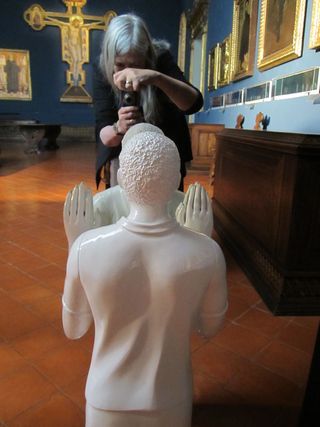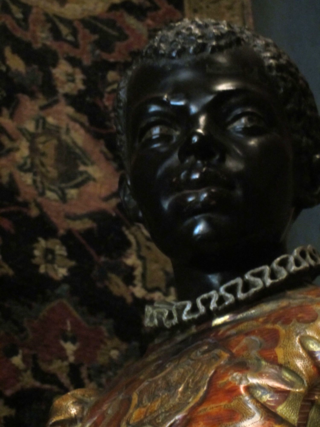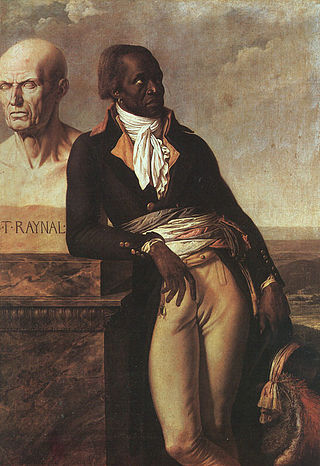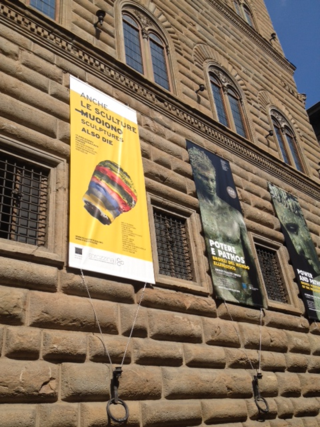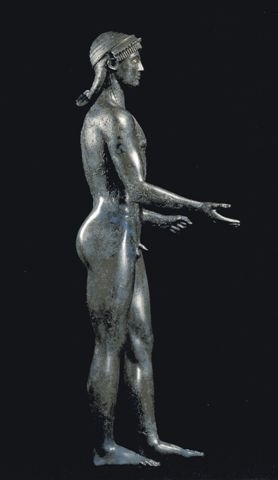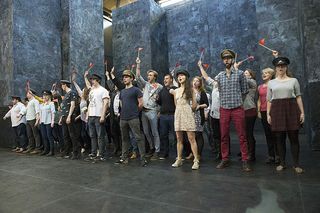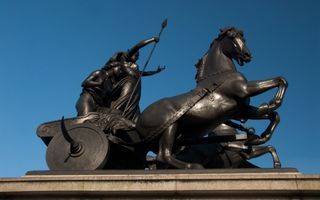Mary Beard's Blog, page 23
June 26, 2015
Sculptures die too
It wasn't only the ancient bronze exhibition that we saw in Florence. Also in the Palazzo Strozzi was a show called "Anche le sculture muoiono" (it's on until 26 July). The title is taken from the 1953 film by Alain Resnais and Chris Marker, Les statues meurent aussi : opening words "When men die, they enter history. When statues die, they enter art. This botany of death is what we call culture". So this show was about different forms of modern engagement with sculptural form, and a good partner for the ancient bronzes.
We spent a happy 15 minutes or so watching a video by Fernando Sanchez Castillo, called Rich Cat dies of Heart Attack in Chicago. It features a series of attempts to destroyed the bronze head of some unidentified ruler, toppled from a triumphal arch . . . could have been a Roman story. Artist's photo below:
I should also add that the Palazzo Strozzi has a wonderful bar/cafe in the courtyard, the Caffe Giacosa (renamed Apollo for the duration of the bronze show), which makes a memorable campari spritz for six euros.
We also went to a museum we hadn't been to before -- which was both full of wonderful things and, even more amazing for Florence, almost totally empty. It's the Museo Bardini, only five minutes or so walk from the Ponte Vecchio, and it has all the feel of the Cloisters in New York. It is actually a museum formed by a single collector and dealer in the late nineteenth century, Stefano Bardini, and it's a great omnium gatherum of medieval and renaissance art. Some really excellent, some not so, but as a collection brilliant. Here's just one piece: a portrait c 1500 by Gian Cristoforo Romano
But we had actually gone to see a special installation, which is on to the 29 August: ReSignifications. It's an exploration of (and play with) the image of the "blackamoor" in western art, partly provoked by the collection of "blackamoors" at Harold Acton's villa near Florence, La Pietra, now owned by New York University. The idea, I imagine, must partly have been that as they couldn't be thrown away, then it might be an idea to undermine them but re-appropriating into a different structure of power.
It worked like a treat, and worth going to for museum and installation. You get the point of the juxtapositions from the pictures below. First, one of Acton's "blackamoors", then a colour photo by Omar Victor Diop, entitled Jean-Baptiste Belley, after the famous painting of a Senegalese slave of the name, which is the third.
June 21, 2015
Power and Pathos in Florence
This weekend, partly to get a few bits of work done in museums, partly to celebrate almost having the book finished, the husband and I gave ourselves a quick weekend in Florence -- with the aim also of catching the "Power and Pathos" exhibition of Greek and Roman bronze sculpture on at the Strozzi palace. It actually ends in Florence on the 21st, but in case you think this account is therefore just a tease for an exhibition that no reader will be able to see, don't worry: it soon moves to the Getty and then to the National Gallery in Washington DC, where some blog readers will be able to see it.
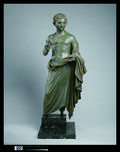 The Strozzi show was very good, though to be honest a bit gloomy as you will see from this video. There is a problem in displaying just 50 or so sculptures all in the same medium, but having them against bronze coloured walls in darkened rooms, with spotlights that meant you were always getting your shadow over the pieces didn't honestly alleviate. The husband had taken his own little torch, which really helped to see the details (this might be a tip for future locations too, unless personal lighting devices are forbidden).
The Strozzi show was very good, though to be honest a bit gloomy as you will see from this video. There is a problem in displaying just 50 or so sculptures all in the same medium, but having them against bronze coloured walls in darkened rooms, with spotlights that meant you were always getting your shadow over the pieces didn't honestly alleviate. The husband had taken his own little torch, which really helped to see the details (this might be a tip for future locations too, unless personal lighting devices are forbidden).
There is a very useful catalogue, with a full entry for every piece. I am getting fed up with "catalogues" that give only essays -- though this one has some very useful essays too, on the history of the genre, new discoveries of ancient broze statues(there are lots from underwater archaeology), etc. I thought the object entries by Jens Daehner, Ken Lapatin and Sophie Descamps-Lequime were especially good and clear.
Lapatin's seemed to be notable models of clever understatement. Try this for a quick few lines on a bronze full-sized male statue from Ephesus, restored in Austria at the very end of the 19th century by Wilhelm Sturm, out of 234 separate small pieces: "Although he was guided by a plaster cast of the Uffizi marble statue reproducing the same type, the Viennese sculptor Wilhelm Sturm faced great challenges on account not only of the sheer number of fragments to be reintegrated, but more significantly of the fact that there is no physical contact between the upper and lower body, so that the figure's mid section had to be entirely reconstructed". That is a very judicious way of suggesting that hundreds of tiny fragments were reconstructed on not much basis, by copying a statue in Florence that may of may not have been like it, and entirely reinventing the whole area around its waist, where nothing at all survived. And at the same time Lapation hints at the bigger question of what "conservation" has actually done to most of these bronzes, in giving us impressive works of art lovingly (re)created from some rather battered and torn bits of metal.
But, heavily restored or not (and it would have been nice to have had some more "before" and "after" pictures), there were some great things here, including what is probably a very nice Augustan princeling above. But for me two statues stood out.
One was an exquisite statuette of weary Hercules, just after finishing his last/next to last labour (getting the Golden Apples of the Hesperides), the subject of a famous statue by Lysippos, here beautifully downsized. It's from a sanctuary of Hercules in Italy and has a gorgeous inlaid silver dedication on the base: "Marcus Attius Peticius Marsus fulfilled his vow". Lapatin observes rightly that the apples are missing, presumably they were -- as the husband realised -- originally gorgeous little golden fruits, as likely nicked as "lost".
The other piece, or pair of pieces, that caught my notice were the "archaising" Apollo found in the house of Julius Polybius in Pompeii 1977 (below) -- a bronze figure made in the first century BC or AD, but in the style of a piece 500 years earlier -- and a rather similar statue pulled from the sea off the Italian coast in the nineteenth century.
This pair is well discussed in Dorothy King's blog, which I recommend that anyone interested should visit. But just to add a few questions. There is a common idea that the Romans who bought these "archaising" statues had been conned. "Got a lovely sixth century BC one, sir" says the unscrupulous dealer, when it has actually been turned out down the road by local antique faking workshop. Isn't is just as likely that they were knowingly buying an elegant reproduction for what it was? After all, it seems to have been the Romans who first articulated the period styles of Greek art, so in this kind of production the artists are playing with those ideas of style, not trying to trick.
Second, as King discusses, the statue in the house of Polybius had been made as, or later adapted into, some kind of "lamp stand" or "tray holder", for use in the house's dining room. The fixings for this are on show in the exhibition, but annoyingly there is no photo in the catalogue (though King has managed to get one). As you will see, it is hard to know how exactly the worked. There is a fixing hole right through the statues open hand, but I couldn't see exactly how the attachments were actually fixed.... and, again annoyingly, there is no diagram in the catalogue (perhaps they couldn't work out either).
This is, I guess, where Roman taste doesn't come out so well. The transformation of a rather elegant piece of bronze sculpture (or sculptural type, if you think it was always made like this) into the ancient equivalent of a canap�� holder or standard lamp might at best be called the democratisation of art... but vulgarisation is also a word that comes to mind.
June 19, 2015
St Polyeuctos gets his moment
Last weekend it was off to the opera at Glyndebourne for me (courtesy of some generous friends) , to see Donizetti���s Poliuto. That���s St Polyeuctos of Armenia to you and me, about whom almost nothing is known, except that he was martyred in the Decian persecutions of the third century -- and he has a famous church in Constantinople.
I hope it doesn���t sound ungrateful if I say that it wasn���t an opera to set the heart zinging in advance (I hadn���t actually heard of it) and it had had some pretty bad reviews for its staging (not for the singing, which was generally agreed to be the tops). But it turned out to be fantastic.
The plot is pretty simple (based on a Corneille tragedy, which ��� another apology ��� I haven't read). Poliuto has become a closet Christian, though his wife Paolina has cottoned on. Her life is soon disrupted by the return of the proconsul Severo, with whom she had been in love, She had only married Poliuto because Severo was believed dead on campaign. So she is faced with her Casablanca moment, but though much torn, she decides not to go back to Severo (a keen persecutor of Christians, unsurprisingly) but to stick with Poliuto and become a Christian and die as a martyr with him.
So what about the staging (pictured above, by R Hubert Smith)? It���s all very twentieth century, somewhere a bit indeterminate between Mussolini and Sarajevo, and the stage is dominated by forbidding towers of concrete, which move around to create different spaces (the church, the bedroom etc), and have videos projected onto them. Most critics were decidedly unenthusiastic: ���visually dull���, ���the incongruity is farcical���, the updating is ���the lamest clich�� in the book���.
That wasn���t how it came across to me, even though I am usually very down on performances of Greek tragedy (esp. Trojan Women) against backgrounds of barbed wire. The whole plot is so bonkers, I thought it needed just this kind of stylised timelessness. How, I wondered, did the critics want it done? Everyone prancing around in togas?
But what intrigued me was the whole early Christian story, especially as I had just been doing that bit in my book (I don���t go as far as the Decian persecutions, but I do look at some of the earlier ones). For a start it seemed pretty clear that Corneille (I imagine) had been reading some martyr acts: probably to judge from Poliuto���s dreams, the Passion of St Perpetua, who famously records the dreams she had in the prison before he execution. (Poliuto above by T Kenton)
It was also interesting to compare the whole plot to the standard movie version of Christian martyrdom (Sign of the Cross etc). There the whole plot turns on the woman being the Christian, and eventually persuading her upstanding Roman boyfriend to join her and face the lions. In Donizetti/Corneille it���s the other way round, which changes the dynamic completely.
���. And, yes, the critics were right about the singing. It was tops.
June 14, 2015
50 shades of sexism
I didn���t think that the Tim Hunt controversy would still be going on, and assumed I had missed my moment. But the papers are still full of it ��� and there are still a few things to be said. So here goes.
First, lets be clear, I have never met Tim Hunt, and I think that his remarks were a combination of stupid, wrong and, to some people, seriously offensive. But whether the outcry in social and other media was proportionate I am not so sure. The idiot ended up giving a very ill-advised recorded interview late at night to the Today Programme, which made matters worse; he has since been door-stepped, and his wife���s first husband has been tracked down. And he has been "shed" from a number of scientific roles, including his Honorary Chair at UCL. Does this really make sense?
This 72-year-old guy made a very big error and probably has some antediluvian views on gender. I would like to smack his bottom, give him a piece of my mind and keep a very close watch on him if he is grading applications. But I wouldn���t drum him out of the academic town.
Besides, a quick campaign against an individual can be an easy deflection from the real underlying issues, about women���s chances in science or in the academy more generally. It is much simpler to take Hunt down a peg or two (deservedly maybe), than to address the bigger political questions of women���s scientific careers (question which need much more thought, effort and probably cash ).
In any case, I have come to think that those old blokes who actually give voice their silly prejudices are a bit easier to deal with/argue against than those who hold much the same views but know better than to utter them out loud (and that sort exists, believe me). Carefully hidden prejudice is the worst of all.
But there are a few more issues too that have been coming out between the cracks.
First: the use of the word ���sexist���. Hunt���s critics have accused him of being ���a sexist���; his defenders have equally vehemently said ���Tim���s not a sexist���. It is if you were either one thing or the other -- when presumably most people are somewhere on the spectrum between the two. I can hardly believe that ���Tim is not a sexist��� in any blanket sense, but it all depends what form it takes, how it is mitigated and in what particular respects (and I am sure there are some) he is not. It would make life a lot simpler if we divided neatly into two ��� sexist and non-sexist ��� but I fear we don���t. Sexism is an accusation not an analytical category.
Second: wit. I thought that some of the social media comments hit the right note. The hashtag #distractinglybeautiful was spot on. But in general a bit more ridicule and a little less high-horse might have been more effective. I was planning a little outburst in which I reflected on how terribly awkward it was working with men because they always believed you fancied them when you didn���t, and because they always bottled up their feelings and didn't ���share���.
(Of course, the fact that that would have been an obvious joke neatly shows that ���standard behaviour��� in the context of a lab is regularly assumed to have stereotypical male characteristics; that���s part of the point. Why not cry for heaven���s sake? Is there something inherently worse about it than shouting or bottling up?)
Third: University College London. I have not been able to discover what his Honorary Professorship there meant exactly, but it cant have been a paid or a contractual position, else they wouldn���t have been able just to get rid of him instantly. To an outsider, it looks as if he was convenient to have on their masthead when he was a distinguished Nobel Laureate; when he looked as if he was a bit of a liability they washed their hands as quickly as they could. If so, it seems a bit instrumentalist to me and even rather unfair.
Or, at least, maybe they should have investigated his views more carefully before they gave him the honour in the first place. If these are his views (and inevitably that is difficult to tell), I cant imagine that this is the first time he has thought or voiced them.
June 11, 2015
Can we, please, clean up Boudicca?
Just opposite the Palace of Westminster, next to the Thames, is one of the most extraordinary public Victorian/Edwardian statues in the whole of London. It is the Thorneycrofts' bronze statue of Boudicca/Boadicea (we don't know how to spell it, but then neither did she), rebel against the Roman occupation of Britain in 60 CE. The statue was finally put up in 1902, though it was begun in 1856, after a lot of discussion and monery raosing.
It is a brilliant piece of Victorian (sculptural) triumphalism and it's one of the relatively few public statues in London to commemorate a woman. As it happens, I am not a particular admirer of Boudicca myself, but that's another matter, and admiration of the person commemorated is not the be all and end all of viewing a sculpture.
I walked passed it today, as most of our great parliamentarians must do half the days of the year. Have they not wondered, I wondered, what a completely crap state she has been allowed to get into. She is a Grade Two listed building (not bad for a rebel) and to all appearances she is remarkably unloved.
The picture above is about the best you can do.
The plinth was originally rather impressive, granite faced. But some service supplier has been allowed to put up service boxes all along the one side.
But even worse, the whole front of the base is now obscured by a t-shirt, baseball cap etc souvenir stall, who have generously hung up a copy of the grand inscription, commemorating the queen, that their stall has concealed -- but it isnt the same as the real thing (now invisible).
And the whole place is filthy, unsurprisingly seeing that a crepe and pancake stall is just a few feet away.
There is a brave but unsuccessful attempt to keep things a bit clean.
But overall the place is a complete tip (and Boudicca herself would have had, I imagine, some fairly stringent ways for dealing with this).
The truth is that, in general, I rather like public sculpture being used rather than admired. But this goes beyond that -- a major work of art treated like a sideshow and a rubbish dump.
If any Lord, Lady or Member happens to read this blog and has a moment to take your mind off the Queen's speech, could you do your bit to clean up Boudicca, in your own back yard?
June 7, 2015
Corrupt...moi?
Let me say to start with that I do not think that way we should make big decisions is by sending hefty bribes to other people's bank accounts. We do not yet know that this is what happened at FIFA. And I am not entirely sure that I count the host nation of the next world cup as a big decision (but I see why those who think it is, think that).
But I guess that I am with most people I know in believing that directly paying to influence a decision isn't on.
That said I am surprised by the confidence of David Cameron et al, who appear to be confident about how you define corruption, and where it starts and stops, and at the cause and effect. The idea that corruption is the cancer of the modern world and that it causes failed states to be failed states may be true; but it could also be possible that those states which are not part of the first world club get pushed into corruption as their only means of getting on. That is the cause and effect, Mr Cameron, are reversed.
My colleague Christopher Kelly wrote about some of these issues in his book Ruling the Later Roman Empire , a well known period of "corruption". I am probably crudifying the argument horribly, but he was suggesting that money was one way of rationing central services that might also be rationed by patronage or by "who you know". Most of the old elite thought that "who you know" was a less corrupt system, but actually cash for services was more democratising. It's worth a read.
Right now, it seems obvious that there are all kinds of ways in which the boundaries between bribery and generosity blur. I have no idea how we entertain FIFA officials when they come to the UK. My hunch would be that they get put in very nice hotels, and get nice opps to go to the theatre or Wimbledon or whatever. Bribery or hospitality?
Every anthropologist for the last 100 years has known, and told us, that gifts are never straight gifts. When I give my colleague or child or greengrocer a Christmas present, or when my students send to me, it is not of course just instrumental (and it's a million miles from what people are claiming that FIFA have been involved in); it comes with generosity and thanks and affection. But it is not NOT instrumental either.
So where do you go from there? Well, you can go down the BBC route and have everyone declare who has given them what and parade it on the website (though quite what good it does anyone for the world to know that the controller of BBCX had a Fortnum's hamper from a grateful production company that s/he shared with the newsroom, heaven only knows).
Or we can all grow up a bit and think about the less tangible, but more important, aspects of probity. I remember many years ago an admissions tutor at an old Oxbridge College telling me that he not infrequently got cases of wine sent by hopeful mums and dads. So what did he do?
He enjoyed them, and it made not a blind bit of difference to his decision. I believe him, it's trust. And it's the best way to stop "corruption".
June 4, 2015
Stairway to heaven
I went for a nice drink and a preview of the Royal Academy Summer Exhibition earlier in the week. I have to confess that I didn't actually pay the exhibits the attention they really deserved, but you could hardly miss what Jim Lambie had done to the main eighteenth century staircase of Burlington House.
That is, he had covered it with hundreds of strips of what 1960's Blue Peter viewers would call "sticky backed plastic". It was a perfect entry to a show that was dramatically themed by COLOUR (even my lack of concentration spotted the pink walls in one of the main exhibition galleries, and that another room was in black and white).
Lambie has done several of these (and it must have taken ages to do, despite the speeded up video on the Academy website). But what is really clever about it is the very simple way it completely transforms the space. Even when it is gone, I wont be able to walk into the Academy, without seeing the stairs in the new way.
It was much the same with what Martin Creed did on the facade of the British School at Rome (above, photo Hugo Glendinning).
Now the British School is a very admirable institution, and provides a research space for UK and Commonwealth academics in Rome, as well as facilities and studios for practical artists.I have spent many happy months of my life there, but I have never thought of it as a risky place... not a place where you might need the kind of "Everything is going to be alright" reassurance.
Creed like Lambie had done this particular slogan in various places, and it no doubt worked differently in the different locations. But as with the Academy stairs, I never pass the British School without seeing the slogan, even though it has long been taken down.
And it has given the place a wholly new and welcome EDGINESS!
(PS regular followers: the new platform has been slightly delayed, but it will come)
May 31, 2015
Exams, and dumbing down
I am just about to start marking a load of degree exams. It is a big job and one that you cant skimp (think -- whenever you are tempted -- would I want the person examining my child to skimp? No.) And it is always interesting and charged.
For me the main issue is one of change and how you might make the comparison between students over the 35 years I have been doing this. Many more people now get 1sts and 2.1's in my university and every other, and there is plenty of talk about dumbing down. Now, students who might be reading this, what I am about to write is not related to what you have written in your scripts... But the basic point for me is that what people write in exams really has got better.
That does not mean the students are cleverer, or that that they have a better capacity for doing a PhD or whatever. But there has been a change.
When I started out in this game, when you marked exams every summer, there really were some dreadful answers. There were students who had clearly done little or no work, and had spent more time on the sports field than the in the library. They blagged a bit, sometimes with a degree of style, and they got at best a 2.2. You would come across grossly irrelevant answers that wrote about the favourite subject of the student that had not actually come up.
Why marks have gone up is because no one knows nothing any longer. All the students, beyond some sad casualties, have worked hard and done enough to get a 2.1 at least, and they actually answer the question asked, with clear information. The 2.1s now are as good as they ever were in my 30 years, I promise.
Students aren't smarter, but they work harder. And we probably teach them better too. But dumbing down?? No.
May 28, 2015
The final straight
I have to confess that I am currently in a combination state of complete exhaustion and perky light-at-the-end-of-the-tunnel energy. I am just finishing the penultimate chapter of the book, and I am looking to finish (apart from all the pics, the end material, the timelines, the whatever...) in about 2 weeks. I know what I want to argue in the last chapter, and if I can only do 1000 words a day, I am there.
Currently I am finishing off a chapter called "Haves and Have-Nots", which is partly trying to ask what we can really say about the culture of those who are not the elite, but also wondering about bigger social political issues.
That really comes down, in a way, to why there wasn't a Roman revolution (despite the title of Syme's book). How was it that the emperors occupied so much of the city (not just the whole of the Palatine, but all the spacious horti etc around the city edges), while a million people were crammed into tenement blocks.. and there wasn't class warfare?
I sort of come to the conclusion that there was more that bound the rich and poor than meets the eye, that there were more shared aspirations and cultural norms than there appear to be. I have always thought it interesting that there was no real difference, for example, between the style of decoration in rich houses from poor houses at Pompeii... only more money behind one than the other. Same things go for the non-elite organisations, such as collegia, which seem to organise themselves on the same principles and on the same terms as elite ones.
Apart from the low level guerilla warfare that went on between the haves and have-nots throughout Roman history, it is not clear what the rallying cries on either side would be. After all, everyone (especially the poor) in the first century CE (say) must have agreed that it was better to be rich than poor. The basic terms weren't contested. I guess (and this is what I shall say) that the revaluation of poverty (and with it the revaluation of the whole hierarchy that Romans took for granted) didnt come till the Christian, which for all its quick embedding in the hierarchy WAS or BECAME a thought revolution.
May 24, 2015
Degree results
How should students receive their degree results? Back in the day (I mean my day) we at Cambridge used to troop to the Senate House at the appointed hour and look at our results as they we posted up, on boards, Tripos by Tripos, in full public view. It was in some ways a brutal system. You discovered how you had done in the full glare of everyone else who was also discovering how they had done (and it was then published in the newspaper too...). But it was also supportive and collaborative. I don't remember an occasion when the student community didn't work together.. mopping up those who had done worse than expected, and those who had done better.
Now the system is that the students get their results online first, then they get put up in the Senate House... but apparently there is a petition to stop even this, that no exam results should be made public at all.
It's not hard to see where the students are coming from... but also not hard to see why the old system might be better than they imagine.
Sure, I understand why the old Senate House system was scary. But it was at least communal and it was actually supportive (and if it exposed any gender disparity then so much the better). There were loads of people there to pick you up, take you to a major drink, reassure you as only contemporaries can that a 2.2 was not the end of life (and it wasnt). Believe me I know.
Currently the system is that you receive the good or bad news on the privacy of your iphone, and the petition argues for going further -- that noone should even know what anyone else got. That would mean the mates cant even swoop round for the restorative drink, when they have seen the bad news posted up.
My point is that privacy in bad news is not always for the best. The old fashioned nineteenth century guys who invented the traditions we have, long before iphones were invented, might not have got it so wrong. Privacy isn't always what helps most.
And, nor, while we are at it, is safety... universities are not supposed to be places (surely?) where you always feel comfortable, or safe, or unthreatened. They are supposed to be places where you feel there is someone to discuss, to debate and support when you do feel that.
Oh dear. I feel a bigger blog coming along.
Mary Beard's Blog
- Mary Beard's profile
- 4110 followers




